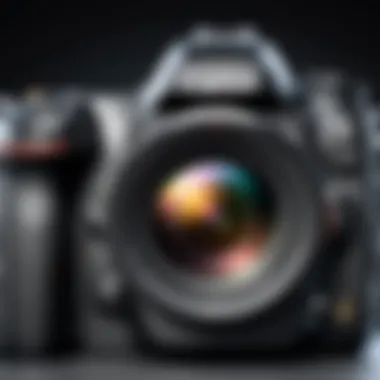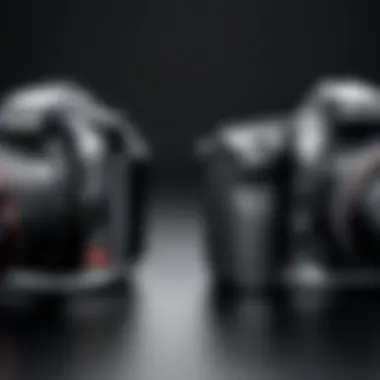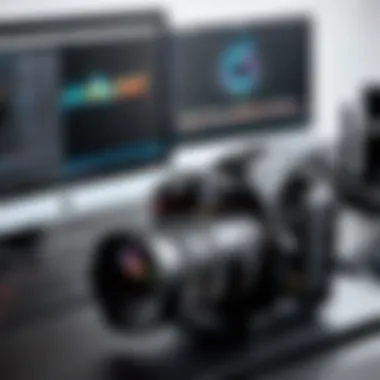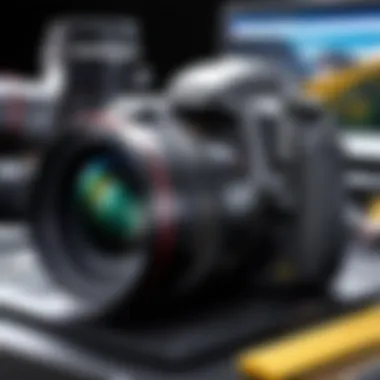Selecting the Ideal DSLR for Webcam Use


Intro
The use of DSLRs as webcams has gained considerable traction, particularly in the realms of streaming and video conferencing. Many individuals are seeking a higher quality alternative to standard webcams in a world increasingly reliant on digital communication. This article explores the process of choosing the perfect DSLR for such purposes. It will highlight essential features to look for, recommend top models, and offer practical setup information.
In examining this topic, we will dissect each aspect that contributes to a successful transition from consumer-grade webcams to professional-level DSLRs. Factors such as resolution, frame rates, lenses, and connectivity options play crucial roles in determining a camera's effectiveness as a webcam. Furthermore, a detailed look into user needs and preferences will guide readers through selecting a model that best suits their requirements.
The Relevance of DSLR as Webcams
The shift toward using DSLRs stems from their superior image quality, flexibility, and control over settings. Unlike traditional webcams, DSLRs provide options for different lenses, allowing users to manipulate depth of field and framing. This quality is particularly valuable for those engaged in content creation, where visuals greatly impact viewer engagement. Additionally, as remote work and digital interactions continue to rise, the demand for high-quality video equipment has surged. Selecting the right DSLR enhances not only the video quality but also the overall professionalism of online presentations.
A well-chosen DSLR can drastically improve your streaming quality, setting you apart from the competition.
Thus, understanding how to effectively choose and use a DSLR for webcam purposes is essential for ensuring that the investment translates into a tangible benefit in both personal and professional contexts.
Preface to DSLR as Webcam
In recent years, the demand for high-quality video content has surged, prompting many content creators to think beyond standard webcams. The rise of live streaming, gaming, and remote work has placed significant emphasis on video quality. Utilizing a Digital Single-Lens Reflex (DSLR) camera as a webcam has emerged as a viable solution for those seeking superior video quality and flexibility in their broadcasts. This article delves into the importance of this transition, considering various elements such as image quality, functionality, and the overall user experience.
Understanding the Transition from Standard Webcam
The standard webcam has long been the go-to choice for video calls and live streaming. They offer convenience and ease of use, but they often fall short in delivering the clarity and detail that viewers now expect. Transitioning to a DSLR opens new avenues for enhanced image quality. DSLRs, with their larger sensors and interchangeable lenses, outperform traditional webcams significantly. The depth of field, color fidelity, and low-light performance of DSLRs allow users to create more professional-looking content. Moreover, when paired with the right software and hardware, the benefits of using a DSLR extend beyond just better images; it also allows for manual control over focus, exposure, and other settings that are typically fixed in standard webcams.
Key Advantages of Using a DSLR
The use of a DSLR as a webcam comes with numerous advantages:
- Superior Image Quality: The larger sensors in DSLRs capture more light, resulting in clearer and more vibrant images.
- Interchangeable Lenses: Users can tailor their setup to meet specific needs by selecting different lenses based on their shooting style or environment.
- Depth of Field Control: DSLRs allow for creative depth of field effects, making the subject stand out crisply against a softer background.
- Enhanced Low-Light Performance: Many DSLRs perform well in low-light conditions, a significant advantage for streaming in less than ideal environments.
"The impressive capabilities of a DSLR camera can elevate your video content to professional levels, setting you apart in a crowded digital landscape."
Criteria for Selection
The selection of a DSLR for webcam use involves careful consideration of various criteria that can impact the overall performance and output quality. This guide aims to clarify these critical elements, ensuring that readers understand what to prioritize when making a decision. By evaluating these criteria, one can find a DSLR that not only meets their needs but also enhances their digital content creation experience.
Image Quality and Sensor Type
Image quality is paramount for any camera used in professional settings, including streaming or video calls. A DSLR's sensor type significantly influences this quality. Full-frame sensors usually provide better performance in low light and offer superior detail and dynamic range compared to crop sensors. This capacity allows for clearer visuals, which can be beneficial for maintaining viewer engagement.
Additionally, the resolution of the sensor plays a vital role. A higher megapixel count translates into sharper images with more detail. This distinction matters particularly in applications where image clarity is crucial. Users should also consider how sensor sizes vary between models and select one that best fits their usage scenarios.
Video Capabilities


Resolution and Frame Rate
The video resolution and frame rate are critical elements to assess. With a higher resolution, such as 1080p or even 4K, content appears more detailed and crisp. This clarity is essential for retaining viewer interest, especially when working with high-motion scenes typical in gaming or esports settings.
Frame rate complements resolution by providing smooth motion. A standard frame rate of 30 frames per second (fps) is often sufficient for static presentations, but for dynamic scenes, 60 fps or higher can make a considerable difference. Therefore, when selecting a DSLR, prioritizing both resolution and frame rate can enhance the overall viewer experience markedly.
Recording Formats
Recording formats also matter, as they determine compatibility with editing software and ease of playback. Popular formats like MOV or MP4 offer a good balance between quality and file size, making them suitable for various applications.
Unique aspects of these formats include their compression methods, which can affect the final output quality. For instance, a higher quality recording format might take up more space but provide better fidelity, crucial for professional use.
Autofocus Performance
Autofocus performance cannot be overlooked when choosing a DSLR for webcam use. Continuous autofocus systems that work efficiently during video capture ensure that subjects remain sharp and in focus, greatly enhancing the professionalism of the content. High-end models often feature advanced autofocus technology capable of tracking moving subjects. This ability helps prevent distracting focus shifts that can detract from the overall viewing experience. It is advisable to look for DSLRs that offer reliable autofocus functions tailored for video use.
Connectivity Options
USB Streaming
USB streaming is becoming increasingly vital for DSLR webcam use, as it allows for direct connection to a computer. This can simplify the process of live streaming or video conferencing. The ease of setup offered by USB connectivity, paired with the capability of transferring high-quality audio and video, makes it a popular choice among content creators.
However, some users may encounter limitations in terms of streaming resolution. It is crucial to verify the specifications for each model to ensure it meets expectations for output quality.
HDMI Output
HDMI output is also essential for connecting to various external devices like capture cards. This option enables higher-quality video streaming than USB in many cases. The benefit of an HDMI connection is that it usually supports higher resolutions and frame rates, allowing for an improved viewing experience.
Nonetheless, while HDMI output provides superior quality, extra equipment such as capture cards may be needed, which can increase the overall setup cost.
Compatibility with Software
Compatibility with software is another key aspect. Not all DSLRs support the same software platforms, which can impact streaming and recording options. Before making a decision, it is advisable to confirm whether the DSLR works well with popular streaming software like OBS or Zoom. This compatibility ensures seamless setup and operation, addressing potential frustrations during streaming sessions.
In summary, the criteria for selecting a DSLR specifically for webcam use encompass multiple important aspects. These include image quality driven by sensor type, critical video capabilities regarding resolution and frame rates, reliable autofocus performance, essential connectivity options, and compatibility with necessary software. Understanding these elements is necessary for making an informed decision, ultimately ensuring a successful digital content creation experience.
Recommended DSLRs for Webcam Use
Selecting the right DSLR for webcam use is essential for achieving optimal image quality and performance. With a myriad of choices available in today's market, understanding the differences in models becomes crucial. This section focuses on key elements such as functionality, build quality, user-friendliness, and overall value for gamers, content creators, and tech savvy individuals. By identifying the best options across different price ranges, users can make informed decisions that enhance their streaming or content creation experience.
Entry-Level DSLRs
Entry-level DSLRs are a gateway to the world of high-quality streaming without causing a financial burden. These models often provide a balance between cost and performance suitable for beginners. When choosing an entry-level DSLR, look for options that offer 1080p video recording, which is adequate for most streaming needs. Additionally, features like built-in Wi-Fi or Bluetooth connectivity can simplify the process of transferring files and controlling the camera remotely.


Some recommended entry-level DSLRs include:
- Canon EOS Rebel T7: Known for its user-friendly interface and solid image quality, this camera is an excellent starter choice.
- Nikon D3500: Offers extensive battery life, a lightweight body, and great functionality that suits novice users well.
These models typically maintain good autofocus systems, allowing streamer and content creators to focus on delivering quality output rather than technical jitters.
Mid-Range DSLRs
Mid-range DSLRs strike a balance between affordability and advanced features. They cater to users who may have previous experience and seek enhanced performance characteristics. In this range, features like 4K recording and improved autofocus capabilities become more prevalent. A camera that offers dual pixel autofocus will significantly improve the streaming experience, making it easier to maintain focus on the subject without manual adjustments.
Recommended mid-range DSLRs are:
- Canon EOS 90D: This camera stands out for its superb image quality and a dual pixel autofocus system that works well in video settings.
- Nikon Z50: With a compact design and excellent 4K video capabilities, it caters perfectly to those who prioritize portability alongside performance.
Choosing a mid-range DSLR can elevate your online presence significantly, providing a professional edge in both clarity and texture of the visuals compared to standard webcams.
High-End DSLRs
High-end DSLRs are for those who demand the ultimate quality and flexibility. While these options come at a higher price point, the investment proves worthwhile for dedicated content creators or esports enthusiasts. Essential features in this category include advanced video recording capabilities, superior low-light performance, and robust build quality that withstands the rigors of extensive use.
Among the top high-end choices are:
- Canon EOS 5D Mark IV: Renowned for its cinematic quality, this camera excels in various lighting conditions and offers excellent frame rates.
- Nikon D850: Known for its incredible resolution and dynamic range, this model is favored for high-detail applications.
When utilizing high-end DSLRs, users can also leverage additional features such as professional-grade lenses, which allow for greater versatility in capturing different scenes and atmospheres. Overall, the high-end category dramatically enhances the quality of digital content, transforming the viewing experience significantly.
Understanding the Technical Setup
The process of using a DSLR as a webcam requires a solid technical understanding. This section covers essential elements necessary to ensure seamless video capture and transmission. Knowing how to set up your device properly can significantly enhance your streaming or recording quality. Key considerations include hardware requirements, necessary accessories, and specific settings and configurations. These will lay the groundwork for achieving the best possible results with your DSLR webcam.
Hardware Requirements
Choosing the right hardware plays a pivotal role in optimizing your DSLR setup. The primary components involve the DSLR camera itself, a suitable computer, and capable interfaces for connection.
Each camera model may have unique hardware needs. Therefore, reviewing your DSLR specifications is crucial. Ensure your computer meets or exceeds software requirements for video capture apps and any potential drivers for your camera. Also, pay attention to the available ports on your computer; USB ports are common but HDMI connections may be needed for higher-quality video feeds.
Necessary Accessories
Capture Cards
Capture cards serve as the bridge between the DSLR and the computer. They facilitate the transfer of video signals, enabling your computer to 'see' the DSLR as a webcam. One of the most beneficial aspects of capture cards is their ability to handle high-quality video, often up to 1080p or even 4K. This is particularly important for streamers who prioritize image clarity.
Notably, popular models like the Elgato HD60 S provide low latency and support for a wide array of cameras. However, they might come at a steeper price. The unique advantage is the reduction of processing time, ensuring smooth and uninterrupted streaming. Users should also note that some cards may require additional software for optimal performance.


Tripods
Stability is essential in videography. A quality tripod helps achieve steady shots, eliminating any unwanted movement that can disrupt your video streams. For this purpose, a durable tripod that can support the weight of your DSLR is vital. Many options are available, including flexible tripods that allow for adjustments in various environments.
A good tripod not only aids in keeping the camera stable but also enhances your framing options. Consider tripods with adjustable height and camera plate designs to quickly change perspectives. The trade-off could be weight versus portability; heavier tripods often provide more stability but can be cumbersome to transport.
Settings and Configuration
Configuring your DSLR correctly is the final step in setting up for webcam use. Adjust settings such as resolution, frame rate, and exposure to match your preferences. Many DSLRs allow users to select specific configurations optimized for streaming.
For example, setting a lower frame rate may help result in smoother content if your connection isn’t robust. In contrast, higher settings will produce better quality but demand more from your computer and internet.
Keeping these technical aspects in check can dramatically impact the viewer's experience and the overall quality of your broadcasts.
Maintaining Your DSLR Webcam Setup
Maintaining your DSLR webcam setup is a crucial step in ensuring the longevity and performance of your video streaming equipment. A well-maintained DSLR not only prolongs the lifespan of the camera but also optimizes the image quality during your broadcasts. Regular checks and proper care can prevent potential issues that could interfere with your streaming and content creation.
The benefits of a consistent maintenance routine include improved video quality, fewer technical failures, and a more enjoyable user experience. Keeping your equipment in optimal condition can help you avoid costly repairs and downtime. Considerations such as cleanliness, software updates, and hardware functionality should be part of this maintenance paradigm.
Routine Maintenance Tips
Establishing a routine maintenance regimen is key to keeping your DSLR webcam running smoothly. Here are some effective tips:
- Clean Your Lens Regularly: Dust and smudges on the lens affect image clarity. Use a lens cleaning solution and a microfiber cloth for this task.
- Check Battery Health: Ensure that your battery is functioning properly. Charge it fully before important streams and consider investing in an extra battery to avoid interruptions.
- Update Firmware: Manufacturers often release firmware updates that improve functionality. Regularly check for updates and install them as needed.
- Monitor Temperature: DSLRs can overheat during extended use. Ensure proper ventilation and take breaks if needed.
- Inspect Connections: Regularly check USB and HDMI cables for wear. Replace damaged cables immediately to maintain connection stability.
Troubleshooting Common Issues
Despite proper care, issues may still arise while using your DSLR as a webcam. Here are some common problems and their solutions:
- Display Not Recognized by Computer: Ensure the camera is set to the correct mode. Restart both the camera and computer, and check cable connections.
- Poor Image Quality: This might be due to incorrect settings. Check the resolution and frame rate settings, and ensure there is adequate lighting.
- Lag or Sync Issues: Use a faster USB connection or consider a capture card. Adjusting settings in your streaming software may also help.
- Camera Overheating: If the camera becomes too hot, switch it off for a while. Use external cooling options if necessary for long streams.
"Maintaining proper upkeep of your DSLR is essential for achieving high-quality video output. Even small adjustments can make a significant difference."
By implementing these maintenance tips and addressing common issues promptly, you can enhance the performance and reliability of your DSLR setup, ensuring that every stream meets high standards.
Finale
The conclusion of this article serves as a crucial element, summarizing the essential points discussed and reinforcing the value of selecting the right DSLR for webcam use. As technology enthusiasts delve deeper into content creation, utilizing a DSLR not only enhances the visual quality but also elevates the overall production standards. A DSLR brings a significant leap in image clarity, depth of field, and color accuracy compared to standard webcams, making it an appealing choice for professionals and hobbyists alike.
Future Trends in DSLR Webcam Use
Looking ahead, we can expect several trends to shape the integration of DSLRs into the streaming and content creation landscape. With the rise of remote work and online content consumption, the demand for high-quality video has surged. This trend is likely to encourage manufacturers to produce more user-friendly options that simplify connectivity and usage for casual users.
Moreover, advancements in software are essential. Streaming platforms may develop better compatibility with DSLR cameras, allowing for more seamless integration. Enhanced features such as real-time focus tracking and improved autofocus systems are anticipated, making DSLRs more appealing for streamers.
Also, there is an increasing interest in incorporating AI-driven technologies. Features like scene recognition may become standard, streamlining the shooting process and providing optimal settings based on user environments.
As the gaming and esports sectors continue to thrive, DSLRs will likely remain a focal point. Their ability to deliver superior quality can greatly influence how current and aspiring content creators engage their audiences. Thus, staying informed about these trends ensures that individuals looking to invest in a DSLR for webcam use are well-prepared for future developments.



